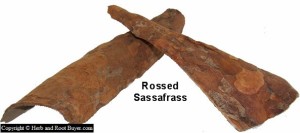Sassafras – Sassafras albidum
|
Current Demand = GOOD |
Parts Used: Leaves & Root Bark |
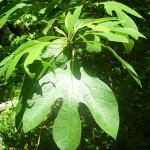 |
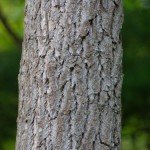 |
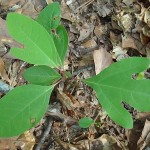 |
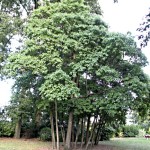 |
Family: Lauraceae
Common Names: Fennel Wood, white sassafras…
Description:
This aromatic tree has red and gold autumn leaves, yellow spring flowers, and small blue fruits on red stalks. It is a medium size moderately fast growing tree with 3 distinctive leaf shapes: entire, mitten shaped, and three lobed. The sassafras is dioecious. It has greenish-yellow flowers that appear in March-April as the leaves unfold. The flowers are tiny and have a five-petal bloom.
The fruit is 8-13mm long and is a single seeded dark-blue drupe. It matures in August and September of the first year. The fruit is borne on a thickened red pedicel, and the pulpy flesh covers the seed. The twig is slender and green with a spicy-sweet aroma when broken. The buds are ¼ inch long and green. The bark is brown, with cinnamon-brown inner bark, becoming coarsely ridged and furrowed, when cut the spicy aroma is obvious.
Harvesting
Parts used: leaves, root bark.
Leaf of the Sassafras tree should be harvested while green in color during the summer growing season. Avoid leaving tree branches and large stems attached to your leaf when gathering.
Sassafras tree bark should be harvested in the spring and early summer when the sap is flowing. Peel bark from only one side of the tree or branch. This allows the tree to heal and continue growing.
Sassafras roots tend to grow shallow especially on hillsides. The root should be cut away from the tree trunk at ground level. Roots grow long and flat with many branches. If your local buyer is willing to buy sassafras roots they will probably need to be smaller roots, the size of your wrist and smaller.
Sassafras root bark is generally harvested in the late winter and early spring when the root bark will separate from the root more easily. Sassafras root bark can be removed from the root when fresh with a hatchet or knife depending on the size of the root and the thickness of the bark. Root bark can be removed from dried roots though it can often be more difficult.
In many areas, Sassafras is plentiful and often seen as burdensome to land owners. When land is being cleared for development or timbering these trees are usually pushed over and burned as scrap. Most land owners will and should allow you to collect the roots after the trees have been dozed over; giving you easy access to a lot of roots and tree bark that would otherwise be wasted. See DRYING NEXT.
Drying
Sassafras leaf, like other leaves need to be dried indoors out of direct sunlight in order to retain their green color and value. Spread your leaves out in a thin layer with access to airflow or place in a mesh bag loosely. Again a barn loft or attic will work well for drying sassafras leaves. Sassafras leaf is dense and holds an abundance of moisture. Therefore it is important to prep your leaves for drying shortly after harvest.
If leaves are allowed to sit in a bag or pile where air does not reach, they will build up a great deal of heat and turn black rendering your harvest worthless. After a few days of drying your leaves should be at a crumbling stage at which time you can place them in paper or burlap for storage until you are ready to sell. Be sure that all leaves are dry prior to storage or they will mold. Store dried leaves out of the sun and try not to crush the leaves once they are dry.
Tree bark is best dried indoors though it can be dried in the sun. Drying time will depend on weather condition, location and thickness of the bark. Bark will be brittle and snap, not bend when dry. Once dry, store the bark in paper, cardboard or burlap. Never store dried roots, herbs or bark in plastic or it will mold. Never mix tree bark with root bark or you will lose money when you sell.
Root bark can be sold two different ways: rossed or natural. Roosed root bark in the inner layer where the root bark meets the root and the rough outer surface removed. Rossed root bark is generally done only when very large roots are gathered and the bark is thick. Natural root bark is simply the clean root bark peeled from the root. After harvest, spray the roots with cold water to remove dirt, mud and debris. Light brushing may be required for cleaning larger roots prior to removing the bark. Sassafras root bark is very susceptible to mold.
To dry root bark, you really need to have access to heat either from the sun or furnace as well as airflow. Place bark in a very thin layer, preferably on a screen so both sides get air and allow to completely dry. Turn bark often to aid in drying. Look for your thickest piece of bark; if it is brittle then the rest of your bark should be dry as well. Again, Sassafras root bark molds easily, so make sure the crop is dry before storing. Do not put dry bark in plastic or it will mold. Store in paper bags, cardboard or burlap with access to air.
Planting/Cultivation:
Growing region: Sassafras can be found very common in the United States from southern Maine to Florida and west to Kansas and Texas. It is often found in fields and along fencerows as well as thickets and roadsides. It thrives in poor soil.
Sassafras is easily grown in average, medium wet well-drained soil in the full sun to part shade. It prefers moist, acidic, loamy soils but tolerated dry, sandy soils. The large taproot makes transplanting of established trees very difficult. If the root suckers are not removed, the tree will spread and begin to take a shrub look.
Seeds: remain dormant until spring. The limit for storage of sassafras in the forest floor is about 6 years.
Attributes (Images)
By Photo by and (c)2006 Derek Ramsey (Ram-Man) (Self-photographed) [GFDL 1.2 or CC BY-SA 2.5], via Wikimedia Commons
Wowbobwow12 at the English language Wikipedia [GFDL or CC-BY-SA-3.0], from Wikimedia Commons
By Pymouss (Own work) [GFDL or CC BY-SA 3.0], via Wikimedia Commons
By Rlevse (Rlevse) [CC BY-SA 3.0], via Wikimedia Commons
 Root Buyer
Root Buyer